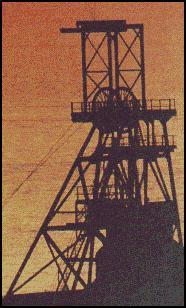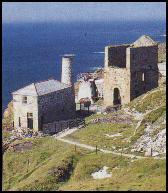


Mining by the sea
Pendeen, TR19 7EW
Tel: (01736) 788762
Email: bookings@geevor.com
Web: www.geevor.com
Web: www.visitcornwall.com/things-to-do/history-and-heritage/geevor-tin-mine
Web: www.nationaltrust.org.uk/visit/cornwall/levant-mine-and-beam-engine/visiting-geevor-mine-on-the-tin-coast
An experience not to be missed, and an important part of Cornwall's rich industrial heritage. Regular tours by expert guides are given around the surface plant, including a short 'walk-in' underground experience. Excellent Craft and Book shop, 'Count House Cafe' and walks along the beautiful Coastal Footpath.
Geevor Tin Mine lies perched on the rugged cliffs of Penwith, high above the Atlantic waves at the very western tip of Cornwall. The mine is the setting of the dramatic story of tin mining in the county. Most of us are familiar with the story of the mass migration of Cornish miners in the 19th century. Leaving Cornwall they played a central role in establishing many mines in foreign countries. But one Cornish mine of modern days owes much to miners who did the reverse. They left South Africa at the very end of the last century and returned to their homeland.
The Boer War broke out in 1899 forcing many miners to leave South Africa and return to the St. Just area. They carefully explored the tin bearing area adjacent to Levant and were encouraged enough by 1901 to form a company called Levant North (Wheal Geevor). There is evidence to suggest that the area had been worked for 2000 years and in fact deep level mining took place up until 1891. In 1904 West Australian Gold Field invested in the venture and a new company was formed. By 1911 Geevor Tin Mines was floated as a modern tin mine. For the next 80 years, and especially after the closure of Levant in 1930, Geevor was the lifeblood of the local community. But things were not always rosy. Mining is a risky and unpredictable business. In March 1873 a miners strike took place and the miners 'rioted' when wages were not paid. The mining companies are exposed to such external factors as volatile metal prices which can wipe out profits overnight, and internal variables such as the capricious tin lodes which can disappear suddenly into barren rock. Geevor was not immune to these crises but its management and men had the tenacity and doggedness to weather the storms and keep in production for most of this century. However, the Tin Crisis of 1985, when the price fell from £10,000 to £3,400 per ton overnight, virtually wiped out the Cornish tin mining industry and Geevor with it. Wheal Jane and South Crofty were fortunate to benefit from Government rescue packages. Geevor was left to die. In August 1986 the mine closed with little prospect of re-opening And then the tin price recovered at the end of 1987. There was a ray of hope for Geevor. it was able to commence mining again on a small scale. But any hopes of a return to full production were soon dashed. With the tin price languishing around £3,000 the mine was finally closed in February 1990. The pumps were switched off in May 1991. The story could have ended there with the mine flooding, the plant broken up for scrap, and the machinery left to rust. It could have, but it didn't.......

A number of individuals and organisations felt strongly that Geevor should not be allowed to suffer an undignified death. The Cornwall County Council stepped in and purchased the mine and Penwith District Council lent its support to the project. But it was the dedication of a group of ex- Geevor employees in particular which was the driving force behind saving the mine. They worked tirelessly throughout long hours to prepare Geevor for the next phase of its long life.
In 1957 the Mine was visited by The Queen and Prince Philip. And in 1980 HRH The Queen visited again.
In August 1993 the mine re-opened, but not as a working mine. Although those involved always hoped that someday Geevor will work again, its future now lies as a Heritage Centre. Geevor is alive again. In the first year of operation close to 20,000 people came to see how tin was 'won' from the ground at Geevor. The Centre, which is open all the year round, has a well-equipped museum where mining artefacts and many displays help portray how the miners lived and worked. An audio-visual presentation relates the story of Geevor mining. Visitors can then take a tour of the surface processing plant where expert guides give the benefit of their local knowledge in explaining the treatment process by which the ore from underground was concentrated. A well stocked book and craft shop, and a cafe can be found next to the museum in the old mine office building. The Heritage Centre offers a visit to the museum as well as guided tours of the surface processing plant and visitors can go underground at Geevor in the 18th century adit. There is a new found confidence in the future. A number of working exhibits are planned which will demonstrate the principles of mining and mineral processing to school children and visitors. Plans are being drawn up that will see Geevor become an important centre of social and industrial heritage in Cornwall. All the development plans will revolve around the fact that Geevor is real. Nothing has to be fabricated or artificially created. Geevor is dirty, cramped and not very pretty but it's real and it's alive!
With visitor numbers continuing to increase PCH identified funding to further develop the 18th century Wheal Mexico Mine visitor route. Study of old mine plans led us to believe that two tunnels, extending from the original visitor route opened in 1995, connected approximately fifty yards further inland and passed through particular mining features . These tunnels had become blocked by sand, gravel and clay washed into the workings over the previous 200 years.
Following success with the funding bid a local mining company carried out the excavation work to re-open the tunnels and carry out essential ground support work, and with the installation of new lighting, the extended route was opened to visitors in 2011.
Further improvements to the visitor experience have occurred over the years making Geevor Tin Mine one of the top Industrial Heritage attractions in the United Kingdom.
Just off the B3306 at Pendeen.
Opening Times10.30am - 5.00pm Sunday - Friday Admission Charged |
Botallack Mine Land's End Levant Beam Engine Pendeen Pendeen Lighthouse East Pool Mine
South Crofty Mine St. Ives St. Just Zennor Folk Museum Mining in Cornwall